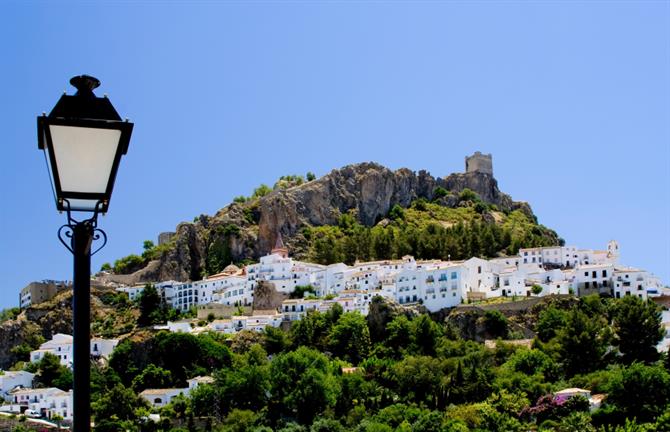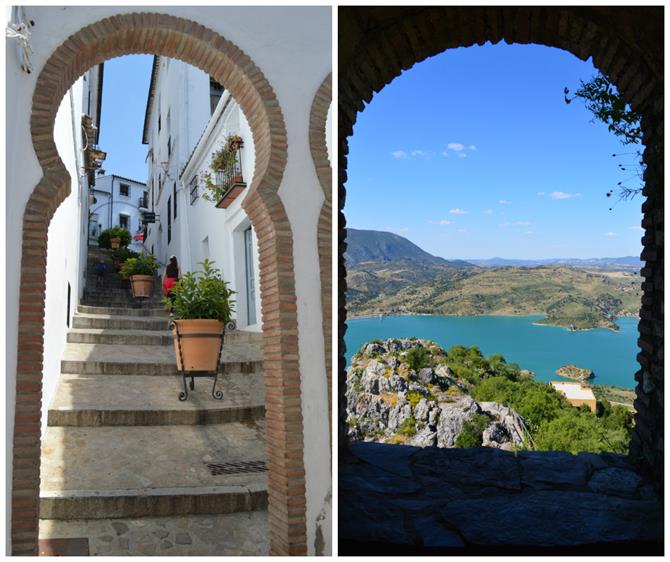Zahara de la Sierra, in the Province of Cadiz, is quite simply a place that takes your breath away. It is without doubt one of the most picturesque of all the Pueblos Blancos (white villages) in the Sierra de Grazalema, if not in the whole of Andalucia.
Only 45 minutes from Ronda, under two hours from Malaga, it is one of the furthest inland villages on the famous Pueblos Blancos route and a visit to Zahara couldn't provide a more spectacular finale. Arriving from the main road, crossing over the waters of the newly built reservoir, the outline of the 13C Nasrid Castle is an impressive sight.
Zahara de la Sierra - A view from the castle by John KramerZahara de la Sierra enjoys an extraordinary setting, sitting at the foot of the Sierra del Jaral, perched on top of a hill and surrounded by the turquoise waters of the Zahara-el Gastor reservoir. Standing guard above the village are the remains of a Moorish castle that commands views over the surrounding countryside and the white-washed village beneath.
The village sits on the north-eastern tip of the province of Cadiz and in the heart of the Sierra de Grazalema Natural Park, a UNESCO Biosphere reserve.
If you're looking for a postcard perfect Pueblo Blanco, this is it.

Orange blossom
The characteristic smell of orange blossom that fills the air, has led to centuries of confusion over the origins of the name ‘Zahara.’ It was originally thought to have been derived from the Arabic ‘Azahar,’ which means orange blossom.
The confusion seems to stem from the Christian reconquest in 1483, when the village was named Zahara de los Membrillos – referring to the quince trees in the area.
The name 'Zahara' has a very different meaning in Arabic, it signifies ‘huge rock,’ which is precisely what Zahara de la Sierra sits on, a huge rock that seems to jut out from the countryside around it.
This privileged geographical setting has meant that Zahara has been an important defensive enclave throughout the centuries for both the Nasrids, and later, the Christians – under the command of Ponce de León.
The history of Zahara de la Sierra

Zahara de la Sierra was an important Moorish outpost and the perfect setting for a fortress. The Nasrid border at the time consisted of a complex network of watchtowers and fortresses that were visually linked to each other and ran the entire border of the Muslim Kingdom. Zahara was continually on the front line of the conquests and reconquests that took place between 1407 and 1483.
The Christians occupied Zahara from 1407 until 1481 and lost the village to the Nasrids in 1481. The fall of Zahara de la Sierra was considered so important, it was used as the pretext for the start of the War for Granada.
The castle at Zahara de la Sierra was one of the main fortresses that protected Ronda and the city of Malaga from Christian raids. The only inhabitants of the village at the time were soldiers, there were no women or children.
After numerous battles and heavy losses, Christian forces under Rodrigo Ponce de León, the Marquis of Cadiz, finally conquered the village in 1483, with Rodrigo receiving the title ''Marquis of Zahara.''
Zahara de la Sierra’s Castle
The most famous landmark is without doubt the 13C Nasrid Castle and lookout tower – the Torre del Homenaje. It is well worth the walk up there, to enjoy the ruins and the spectacular views of the surrounding countryside.
The remains that are visible today, date from the 14th century. However the castle was built on top of an 8th century watchtower. Recent renovation work make visiting the castle very straightforward. There’s a visitor’s centre and various viewing platforms. A walk up there is a must. The castle itself is fairly disappointing, but the views are unbeatable.
The walk up is fairly steep and can be hot going in the summer months, but it's definitely worth the effort. The Torre del homenaje - the lookout tower has recently been renovated and is open to the public.
For the best views you can climb up three flights of stairs to the upper terrace. Watching the sunset from the top is particularly magical. You can also clearly see part of the old Nasrid early warning system, with the castles of Olvera, Matrera, Cote and Algodonales all visible in the background.
Things to do in Zahara de la Sierra
Zahara is not a big place and within a couple of hours you can see most, if not all of the town’s main attractions.
The 17th century Santa María de la Mesa Church, the 19th century San Juan de Letrán Chapel, the 16th century Torre del Reloj (Clock Tower) and the Palominos Bridge, of Roman origin, are all within easy walking distance from each other.
The centre of the village is a delight to wander around and was declared a Patrimony of Humanity by UNESCO in 1977 and an Historical-Artistic Centre (Conjunto-Histórico) in 1983.
The castle and the torre del homenaje are the highlight of any trip to Zahara. The museum which is situated just above the village on the way up to the castle is worth visiting. It offers a fascinating glimpse into Zahara’s past and present.
The religious festival of Corpus Christi that takes place in June is of note and has been declared a Fiesta de Interés Turístico Nacional.
La Playita - Arroyomolinos Recreational Area
Zahara can get very hot in the summer months and there is no better way to cool down than swimming in the clean waters of the embalse. The village also offers a large municipal swimming pool that is open from mid-June onwards.
Another great spot for a swim or to spend the afternoon is ‘La Playita’ – the little beach. Situated in the Arroyomolinos Recreational Area. The spring fed miniature lake that borders the embalse provides safe swimming for the whole family. There are lifeguards, six hectares of lush gardens with barbecue pits and a cafe-bar/restaurant.
An adventure company (zaharacatur.com) has recently taken over the whole facility and installed a treetop adventure park with ziplines, swinging bridges, a climbing wall and all kinds of fun things to keep the whole family entertained. You can also go horse riding from here. Aside from swimming, you can go kayaking, sailing and fishing in the embalse.
For directions, see the map below. The Playita and the municipal swimming pool are open from 11.00am until 7.00 pm and cost between 1.50€-3.50€ entrance per day. The activities are extra.
Other activities near Zahara de la Sierra
Hiking - hiking doesn't get any better than in the Grazalema Natural Park. Two of the best routes in the area are along the Arroyo de Bocaleones and a hike up Cerro Coros.
Birdwatching - Zahara is a paradise for birdwatchers. You can spend a day out with one of the area’s leading experts Peter Jones - spanishnature.com.
Cycling - the award winning Via Verde de la Sierra is close by. For a far more strenuous ride you can cycle up to the Puerto de las Palomas from Zahara. A popular, yet grueling route.
Paragliding - the neighbouring village of Algodonales is one of Spain’s leading paragliding locations. There are numerous schools and companies that cater to all levels.
Olive oil - this is olive oil country and home to some of Andalucia’s best. A visit to the Molino El Vínculo (molinoelvinculo.com), an olive mill that dates from 1755 and still grinds olives using stone presses is recommended. For an ecological option, the more modern Oleum Viride mill (oleumviride.com) is the place to go. They both offer tours and sell homemade olive oils.
Wines - Ronda is one of the most recent additions to the official wine routes. For a suggested wine route in Ronda.
La Garganta Verde
Just on the outskirts of Zahara is the entrance to the spectacular Garganta Verde. A natural paradise that is well worth exploring.
Walking through the gorge is an unforgettable experience, with steep cliffs on either side that rise up to over 400m. The path gets progressively narrower and narrower, until you start having to walk in the river, criss-crossing crystal clear pools. Eventually coming to areas that require ropes and nerves of steel to go down. Not unsurprisingly it is a paradise for climbing and canyoning.
The Garganta Verde is also home to one of Europe’s largest populations of Griffon vultures. About a third of the way down you need to veer off to a viewing platform. Make sure you ask for directions.
This is one of the most protected parts of the Grazalema Natural Park and permissions are needed beforehand. You can obtain them in the visitors centre in El Bosque (+34 956 709733).
Surrounded by lush gardens, narrow windy streets, steeped in history and with a distinct Moorish feel – Zahara de la Sierra is one place that is not to be missed.
